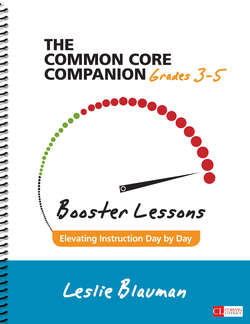Читать книгу The Common Core Companion: Booster Lessons, Grades 3-5 - Leslie Blauman - Страница 12
На сайте Литреса книга снята с продажи.
Think Intentional Teaching
ОглавлениеTeach with intention is another bit o’ wisdom that talking heads in education use, and as a practicing teacher of twenty-nine (!) fourth graders, my response is often an eye roll and followed by “Well, duh!” said with the perfect pitch intonation of a ten-year-old. Like we’re gonna just go in and wing it without plans and hope students pick up a few skills by spring? It’s all the more ironic, then, that I actually think highly enough of the concept of integrating more intentionality into our days to give it a real presence in this book. But my brand of intentionality is really, really concrete, even mechanical. You will see it show up in two ways in these sequences. Well, maybe three.
The first way is the sequence itself—the very notion of purposely linking reading and writing in a day, connecting it to the work you and students do with language, grammar, and so on.
The second way intentionality makes its mark is the If/Then Chart provided within the Next Instructional Steps section that follows each sequence, where I show you the things I tend to assess and evaluate—and then what I do with it in terms of going forward. All of our teaching—and really, all of our life—is one big If/Then—but here, with the If/Then Chart, I’m highlighting the process of intentionally evaluating students’ learning in order to respond and intentionally, incisively, plan subsequent lessons and conferences.
The third way I help you think about intentional teaching is through the three-week unit calendars provided for each sequence at www.corwin.com/commoncorecompanion. As I mentioned, each sequence is a week or two of instruction; the exact duration is up to you. You can dive in to any of these sequences, do them start to finish, and call it a day. Or, you can begin by looking at the more ambitious four-week unit plan, and use it to help you try units of study for the first time or deepen them. Then the sequence tucks within the unit. The reality is, any one of these sequences can springboard into a longer unit of study. The minute you combine worthy standards, rich texts, interesting questions, relevant writing ideas—well, it’s like Mentos in a cola bottle. Expect a fizzy explosion of further questions, information, additional texts, and discussion. By planning a unit of study, you take command of the line of inquiry, and you guide students in ways that better ensure you use the weeks wisely and address key skills and content along the way.
Flip back a few pages to the sectionBooster Lessons, At a Glance. There, you get a visual tour of the recurring features of the sequence and its purpose. This will give you a vivid sense for how lessons connect to each other, and how all the ELA standards meld together in a seamless whole.
Intentionality. Use this guide to fit your needs and more importantly your students’ needs. Mark it up, take the parts that work for you—but remember best practice. Keep an eye on the core practices and think of how you’re implementing them. But most importantly keep this one thought at the forefront—are you teaching your students to read, write, and think—and to love doing it?
